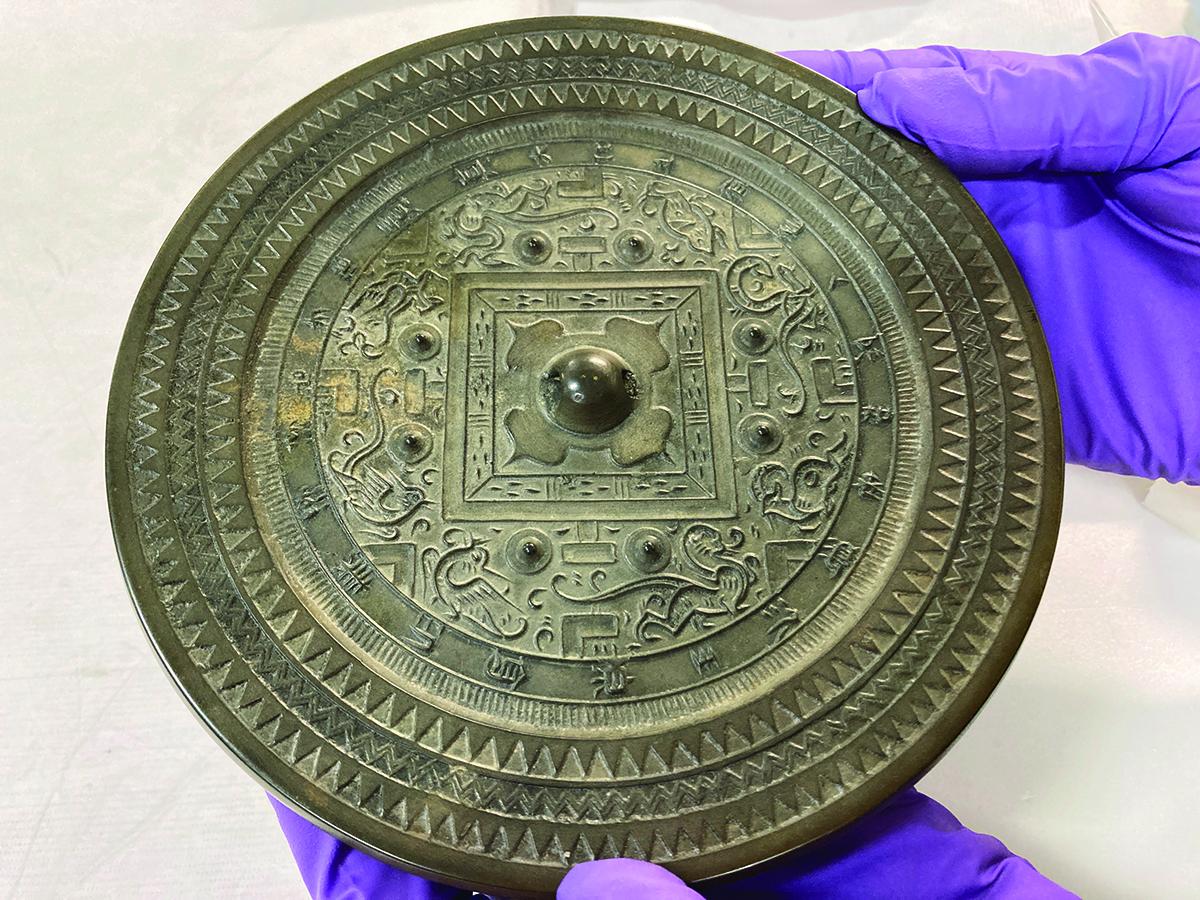
by Yuan Fang, PhD Candidate, Department of Anthropology
One summer break back home in China, I visited the Henan Museum and found myself drawn to a bronze mirror on display. I had seen many before, but something about this one stopped me. Its delicate designs were beautiful, but I couldn’t stop thinking about what it meant. I pictured a Tang dynasty court lady using it for daily grooming—the familiar image often used to represent bronze mirrors as feminine tools tied to beauty. Then I thought of Fu Hao, the Shang dynasty queen and military general from my home province. She didn’t fit that traditional idea of femininity. Did she use bronze mirrors, too? Did her husband, King Wu Ding, have one? What kind of designs did they prefer? Could commoners own mirrors? That moment made me start asking different questions. It wasn’t just about what bronze mirrors looked like, but what they revealed about people’s lives.
In both academic studies and public media, mirrors are often portrayed as feminine objects tied to beauty and domesticity. In archaeological contexts, they’re frequently grouped with items like hairpins and toiletry tools—and together, these are used to infer the sex of the deceased, typically assumed to be female. But as I looked deeper, I realized that my questions needed to go beyond the mirrors themselves. I wanted to understand not only how mirrors were used across different gendered contexts in ancient China, but also how the interpretations we rely on today are shaped by modern assumptions. With support from CSWS, I’ve explored these questions as part of my dissertation, which examines how bronze mirrors reflected or resisted social categories—and how archaeologists have constructed those categories through their interpretations.
To explore these questions, I built a dataset of 1,411 bronze mirrors excavated across China, drawing mainly from reports published in Kaogu (“Archaeology”), a leading Chinese archaeological journal, between 1980 and 2024. I recorded mirror types, decorative patterns, tomb locations, dynastic periods, co-buried objects, and the assigned sex and rank of the deceased. As I worked through these reports, I noticed patterns—not only in the finds but in how they were interpreted. In many cases, the reported sex wasn’t based on skeletal or genetic evidence but inferred from the presence of toiletry tools like combs and cosmetic boxes, or personal ornaments. For example, tombs in the 1994 Xuzhou and 2016 Hubei reports were labeled female for this reason (Cao et al. 2016; Xuzhou Museum 1994). Similarly, the 2002 Xi’an and 2009 Xuzhou excavation reports identified male tombs based on the presence of weapons (CASS Xi’an Team 2002; Xuzhou Museum 2009). These examples are not outliers—they reflect a broader trend in how gender is constructed through burial interpretation.
This led me to examine how archaeologists describe burials that don’t fit expected gender roles. Mirrors are often highlighted in tombs labeled female, reinforcing assumptions about beauty and femininity. But in tombs labeled male—often due to weapons or scholarly tools like brushes and inkstones—mirrors are sometimes present but barely discussed. One example comes from an excavation in Jiangxi: two bronze mirrors were found in a wooden box along with toiletry items and scholarly tools, all buried with an iron blade (JPM 1983). The tomb was identified as male based on the scholarly tools, while the mirrors and grooming items—typically cited as feminine markers—were downplayed. Other cases show similar contradictions. A tomb in Shandong, labeled male, included gold and silver hair ornaments (Jining Regional Bureau of Cultural Relics 1983). One tomb contained both iron weapons and face powder (SHC-SDU & SPICRA 2023). Another held bronze ornaments alongside weapons (Luoyang Institute of Cultural Relics and Archaeology 2024). Some of these finds involve mirrors, others do not. However, they all reveal the same issue: Ancient material culture doesn’t always conform to binary gender categories. These contradictions challenge long-held frameworks and call for more nuanced interpretations.
I keep returning to the question that first came to me in the Henan Museum: How did someone like Fu Hao—a queen, general, and high priestess—use bronze mirrors? Her tomb at Anyang, one of the most significant archaeological discoveries in China, contained weapons, ritual bronzes, and four mirrors. She didn’t fit the conventional image of femininity, yet she was buried with objects tied to both masculine power and feminine adornment. For me, what began as a moment of curiosity in front of a museum piece has grown into a broader investigation into how gender, power, and interpretation intersect in the archaeological record. Mirrors may reflect faces—but they also reflect the assumptions of those who study them. And it’s those reflections I now study most closely.
—Yuan Fang received a 2024 CSWS Graduate Student Research Grant for this project.
REFERENCES
Cao, Zhao, Qing Zhou, Ran Wang, and Xuelai Li. 2016. “Two Tombs from the Southern Dynasties were Discovered in Hubei Yun County Liaowadianzi.” Kaogu, no. 4: 116-120.
Jiangxi Provincial Museum (JPM). 1983. “Excavation of Eastern Wu Gao Rong’s Tomb in Jiangxi Nanchang.” Kaogu, no. 3: 219-228, 196-300.
Jining Regional Bureau of Cultural Relics, Shandong Province. 1983. “Excavation of Yuan Dynasty Cao Yuanyong’s Tomb in Shandong Jiaxiang County.” Kaogu, no. 9: 803-809, 869-870.
Luoyang Institute of Cultural Relics and Archaeology. 2024. “A Dated Western Jin Dynasty Tomb in Chanhe District, Luoyang, Henan.” Kaogu, no. 10: 53-68.
School of History and Culture, Shandong University (SHC-SDU) and Shandong Provincial Institute of Cultural Relics and Archaeology (SPICRA). 2023. “2022 Excavation of Shigu Cemetery in Zibo, Shandong.” Kaogu, no. 11: 39-53, 121-122.
Xi’an Tang City Excavation Team, Institute of Archaeology, Chinese Academy of Social Sciences (CASS Xi’an Team). 2002. “Excavation of Western Han Dynasty Tombs in Longshou Village in Xi’an Northern Suburb.” Kaogu, no. 5: 31-46, 98-99.
Xuzhou Museum. 1994. “Excavation of A Han Tomb in Jiangsu Xuzhou Jiulishan.” Kaogu, no. 12: 1063-1068.
Xuzhou Museum. 2009. “No. 2 Han Tomb in Jiangsu Xuzhou.” Kaogu, no. 4: 41-51, 108-112.

